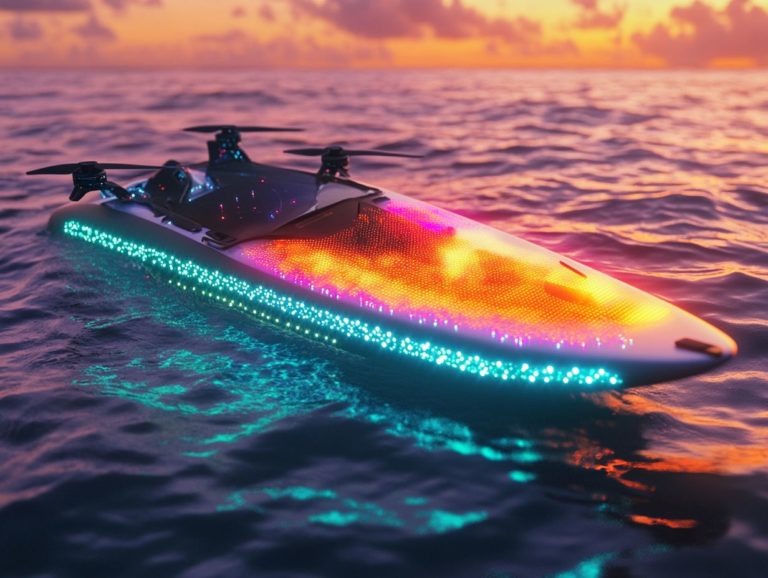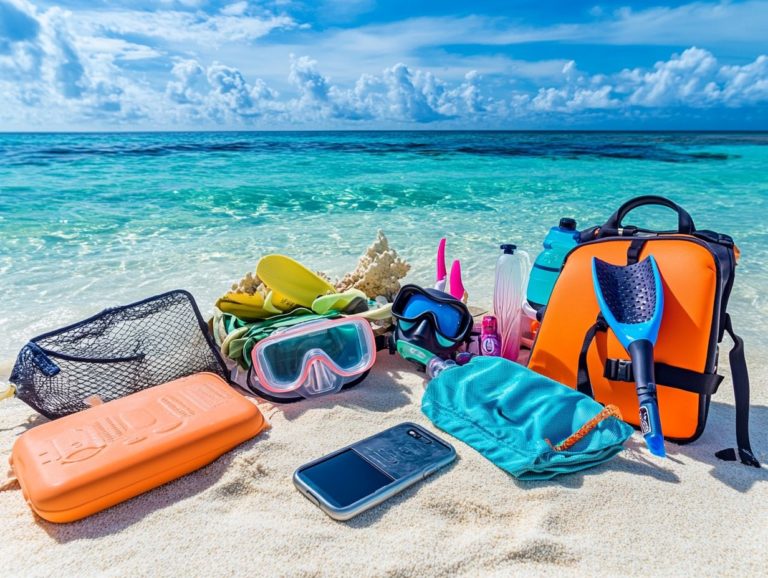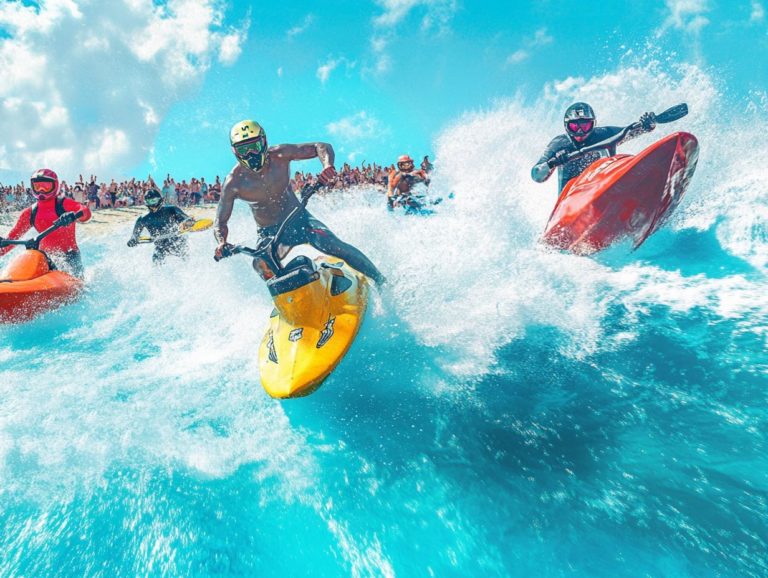Choosing the Right Type of Kayak for Your Needs
Pick the perfect kayak, and watch your outdoor adventures soar! Whether you’re gliding across serene lakes, navigating swift rivers, or casting lines for a rewarding catch, the right kayak can make all the difference.
With an array of options recreational, touring, fishing, whitewater, and inflatable each type caters to a distinct purpose.
This guide will walk you through the various kayak types and essential considerations, including intended use, size, stability, and extra features.
By the time you finish, you’ll be fully prepared to select the perfect kayak that aligns with your adventurous spirit.
Contents
- Key Takeaways:
- Types of Kayaks
- Considerations for Choosing a Kayak
- Key Features to Look For
- Frequently Asked Questions
- What are the different types of kayaks available for different needs?
- What should I consider when choosing the right kayak for my needs?
- What is the difference between a sit-in and sit-on-top kayak?
- Can I use a recreational kayak for whitewater kayaking?
- What is the difference between a hard-shell and inflatable kayak?
- Do I need any additional equipment when kayaking?
Key Takeaways:
Here are the key points to remember when choosing your kayak:
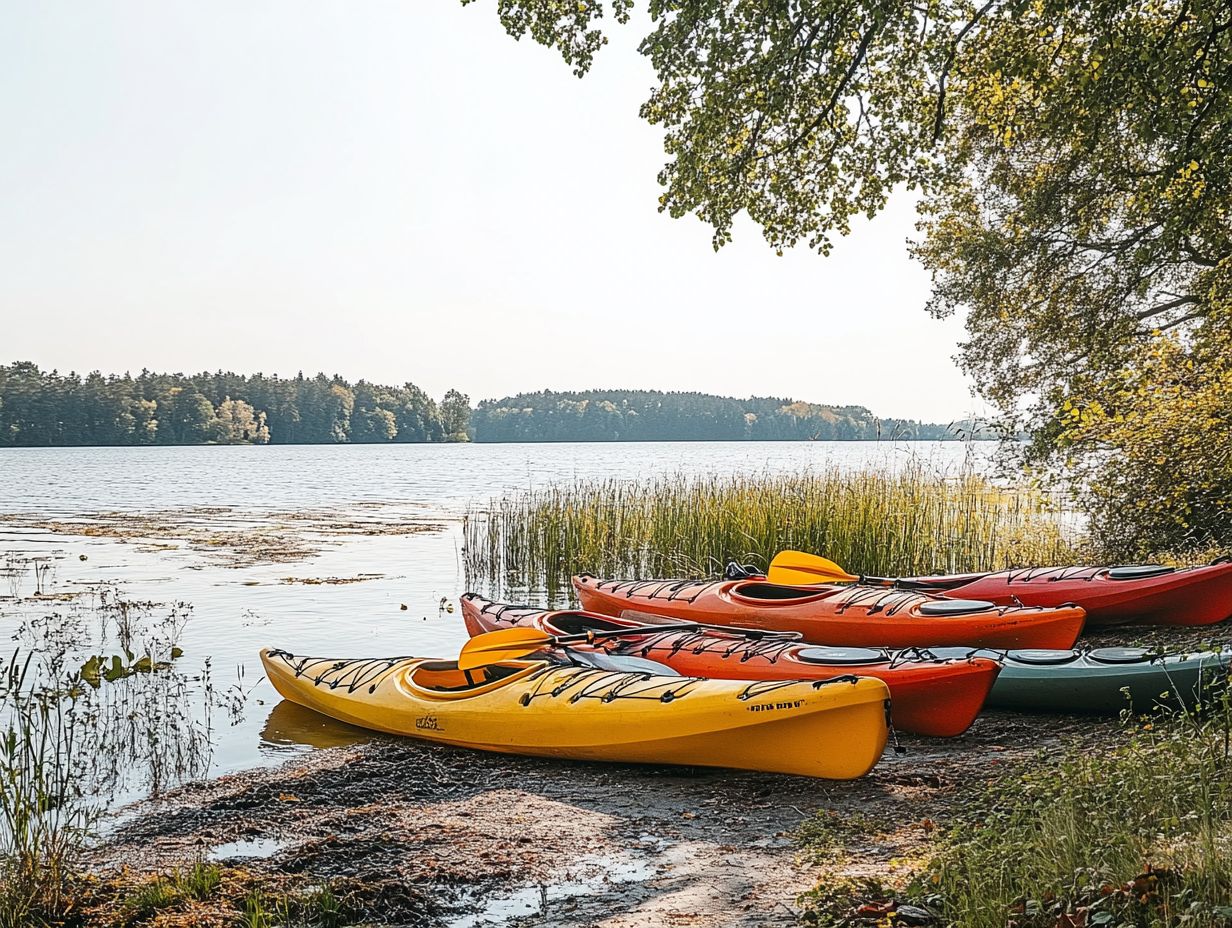
- Choose a kayak based on your intended use, such as recreational, touring, fishing, or whitewater.
- Consider the size and weight capacity, as well as the stability and maneuverability of the kayak.
- Additional factors to consider include seating and comfort, material and durability, and price and budget.
Types of Kayaks
Understanding the diverse world of kayaks is crucial for both enthusiasts and newcomers. You’ll discover an array of kayak types, each designed for specific activities and environments.
From recreational kayaks to sit-on-top and sit-in models, inflatable options, and specialized variants for touring, fishing, whitewater, and racing, the choices can be overwhelming. Selecting the right kayak will significantly enhance your paddling experience.
It ensures safety, comfort, and performance across various water settings, whether you’re gliding on serene lakes, navigating rivers, or tackling the open sea.
Recreational Kayaks
Recreational kayaks are crafted with casual paddling in mind, perfect for leisurely outings on calm waters. This makes them an exceptional choice for beginners and families alike.
These versatile vessels emphasize stability, ensuring that you feel secure even on gentle waves or within sheltered lagoons. Typically lightweight, they allow for easy transport and maneuverability, a significant advantage for those just dipping their toes into the world of paddling.
Unlike their sea or touring counterparts designed for speed and long distances recreational kayaks prioritize comfort and accessibility. They excel in lakes, slow-moving rivers, and estuaries.
With their wider hulls enhancing stability and minimizing the risk of tipping, these kayaks provide a user-friendly experience. This guarantees that everyone, from the littlest paddlers to the most seasoned grandparents, can enjoy a delightful day on the water.
Touring Kayaks
Touring kayaks, typically longer and narrower than their recreational counterparts, are designed for extended excursions on expansive bodies of water, like coastal seas and vast lakes.
These thoughtful design elements enhance tracking and efficiency, enabling you to cover greater distances with less exertion. The stability provided by this configuration is vital, especially when tackling choppy waters or strong currents.
Their versatility makes them well-suited for a range of environments, from tranquil lakes to more demanding oceanic conditions.
When planning your adventure, consider safety equipment such as life jackets, navigation tools, and appropriate clothing, ensuring that your experience on the water remains secure and truly enjoyable.
Fishing Kayaks
Fishing kayaks are carefully designed to elevate your angling experience on the water, featuring an array of specialized attributes that prioritize both stability and user-friendliness.
These vessels provide plenty of storage space for your gear, making sure all your equipment is within easy reach for a successful day out, from tackle boxes to cooler space. In terms of weight capacity, many fishing kayaks can accommodate larger loads than their recreational counterparts, perfect for carrying that extra equipment you might need.
With propulsion methods like pedal drives, you can glide effortlessly across the water, allowing for hands-free fishing. Unlike traditional kayaks that often depend solely on paddles, fishing kayaks offer a remarkable advantage in maneuverability.
Brands like Hobie and Old Town have set the gold standard in this niche, renowned for their durability and thoughtful design that truly enhance your overall fishing experience.
Get ready to hit the water with confidence and excitement!
Whitewater Kayaks
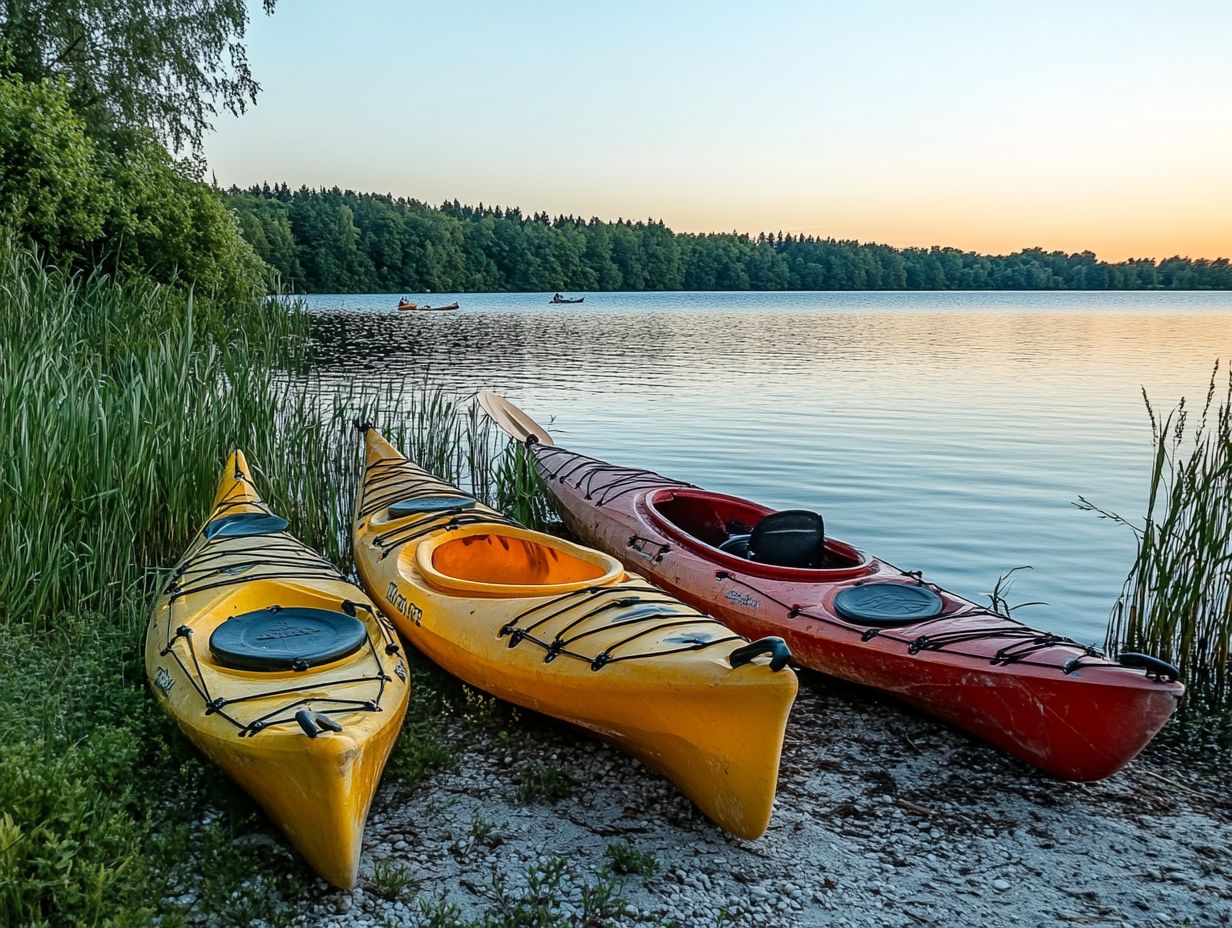
Whitewater kayaks are specifically engineered for navigating turbulent river currents and rapids. They boast robust construction and specialized hull shapes that prioritize both maneuverability and safety.
These kayaks are crafted from durable materials like polyethylene or fiberglass. These materials offer resilience and flexibility, ensuring they withstand bumps and scrapes.
The hull shapes vary significantly. You can choose from flat-bottomed to rounded designs based on river conditions.
Safety equipment, including life jackets and helmets, is essential for enhancing your safety as you tackle unpredictable waters. It’s also essential for you to practice skills like quick turns, reading the river, and mastering self-rescue methods to navigate various river types with confidence.
Inflatable Kayaks
Inflatable kayaks present a remarkable blend of portability and ease of storage, making them an attractive choice for recreational paddlers like yourself who often explore various water environments.
These versatile vessels can be conveniently packed into a manageable size, slipping effortlessly into the trunk of your car or even making the journey on public transport. This is a significant advantage over traditional rigid kayaks, which require more space and effort to transport.
However, while inflatable kayaks are lightweight and generally stable on calm waters, they may sometimes lack the rigidity and performance that hard-shell models offer. When selecting an inflatable option, consider features such as:
- Reinforced seams
- Multiple air chambers for added safety
- A design that aligns with your paddling style whether you prefer leisurely outings or more adventurous excursions.
In contrast, rigid kayaks typically deliver better steering and speed, making them the go-to choice for experienced paddlers who crave enhanced performance.
Considerations for Choosing a Kayak
Selecting the perfect kayak is an essential choice that can profoundly influence your paddling adventures. It’s important to consider several key factors tailored to your intended use and the specific water environments you plan to explore.
Intended Use
The intended use of your kayak is a crucial factor to consider when making your selection, as it directly influences the type of kayak you should choose.
Different activities be it recreational paddling, fishing, touring, or whitewater rafting each demand specific characteristics in a kayak to enhance both performance and enjoyment.
If your primary goal is to enjoy leisurely outings on calm waters, you’ll want a stable, wide recreational kayak with ample storage for picnic supplies or fishing gear.
On the flip side, if you’re chasing adrenaline on swift rivers, a specialized whitewater kayak, known for its shorter length and enhanced maneuverability, becomes essential.
For those who embark on longer excursions, touring enthusiasts might opt for sit-in kayaks designed for efficiency and tracking. This enables maximum distance with minimal effort.
Ultimately, your choice hinges on how these activities resonate with your personal goals and the environments you plan to navigate.
Size and Weight Capacity
The size of your kayak, encompassing its length and width, significantly influences its stability and weight capacity two critical factors for both safety and performance.
A longer kayak generally provides enhanced speed and superior tracking, making it ideal for open water conditions. However, these elongated designs may sacrifice some initial stability, which could be tricky for beginners.
Conversely, shorter kayaks offer increased maneuverability and stability but may have limitations when it comes to weight capacity. Grasping these measurements is essential for selecting a kayak tailored to your specific activities, such as fishing or touring, where weight distribution can profoundly affect overall handling.
By carefully considering the advantages of different sizes, you can ensure a safer and more enjoyable paddling experience.
Dive into the water with the perfect kayak for your adventures your journey awaits!
Stability and Maneuverability
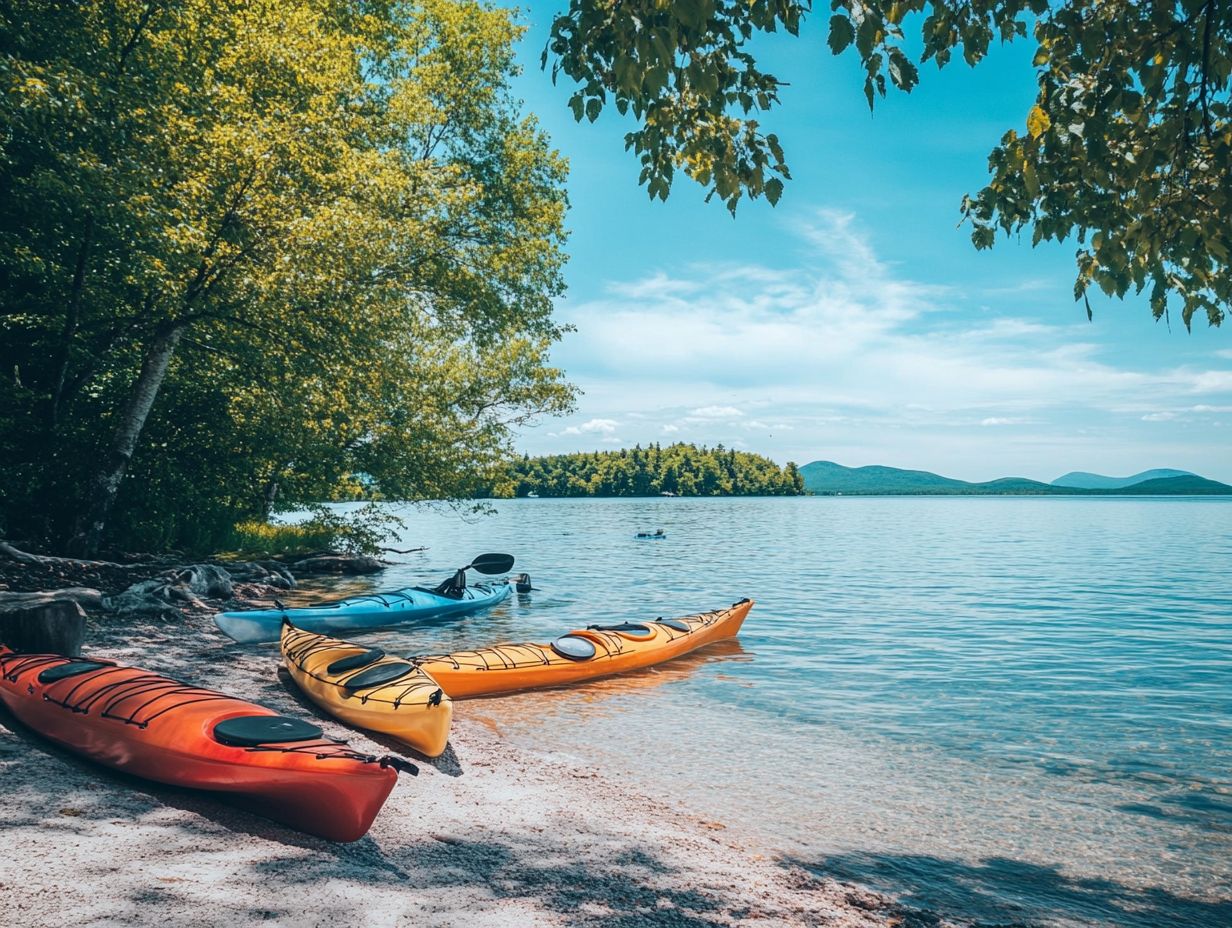
Stability and maneuverability are essential attributes that greatly affect your kayak’s performance across different water environments. These factors impact everything from your comfort to your safety.
The shape of the bottom of your kayak plays a pivotal role in defining these characteristics. For instance, a wider hull often offers enhanced stability, making it ideal for calmer waters where ease of paddling is key. On the flip side, a narrower hull typically boosts speed and maneuverability, perfect for those who seek adventure in swift rivers or open seas. To further enhance your experience, consider checking out our guide on how to select the best fishing kayak.
These design variations not only affect how your kayak handles turns and choppy waves, but they also shape your overall paddling experience. This influences how secure you feel and how effortlessly you can navigate through your chosen environment.
Storage and Transport
When choosing a kayak, consider storage and transport, especially if you plan to explore various water environments or have limited space at home. Inflatable kayaks present an outstanding solution, as they can be effortlessly deflated and packed into compact sizes that fit snugly in your car trunk or closet. This feature makes them ideal for recreational kayaks.
This convenience allows you to discover a range of locations without the usual hassle of dealing with bulky hard-shell kayaks. The lightweight design of these inflatable options means you can easily handle loading and unloading by yourself. This makes those spontaneous trips to lakes or rivers much more enticing, whether you’re using a pedal-powered system or a traditional paddle.
Whether you’re planning a weekend outing or an extended adventure, inflatable kayaks open up a world of adventure! They offer you the freedom to indulge in your passion without the constraints typically tied to traditional storage or transport challenges.
Key Features to Look For
When choosing a kayak, consider additional features like seating comfort, material durability, and price, as well as the kayak’s weight capacity. By doing so, you can significantly elevate your paddling experience and overall satisfaction.
Seating and Comfort
Seating and comfort are essential elements of your kayaking experience, particularly if you plan to spend extended hours on the water in recreational kayaks or touring kayaks. The right seating options can significantly elevate your enjoyment during long paddling trips.
For example, adjustable seats allow you to find your perfect fit, tailored to your unique body type and personal preferences. These customizable features can minimize discomfort and alleviate the strain often associated with hours spent sitting in sit-in kayaks or sit-on-top kayaks.
Many kayaks come equipped with supportive backrests and cushioned seats, further enhancing your comfort. When you take these factors into account, it becomes evident that selecting the appropriate seating arrangement can not only boost your comfort but also enhance your overall performance and enjoyment in various types of kayaking, whether you’re a novice or a seasoned paddler.
Material and Durability
The materials you choose for kayak construction significantly impact its durability and overall performance. Among the most common options are polyethylene, fiberglass, ABS plastic, and composite materials. Each brings its own unique characteristics to enhance your experience on the water, especially in specific water environments like rivers and lakes.
Polyethylene is a favorite for its impressive durability and impact resistance, making it an excellent choice for recreational kayaks though you might find it a bit heavier than some alternatives.
On the other hand, fiberglass kayaks are lighter and deliver superior performance, making them suitable for racing, but they often come with a heftier price tag and may be more prone to scratches.
ABS plastic offers a balanced solution, providing decent weight and durability at a more affordable price. However, it might not handle extreme conditions as well as some other materials.
Finally, composite materials merge various elements to create kayaks that are both lightweight and robust. Just keep in mind that this premium option typically carries a higher price, which might not suit the casual paddler s budget.
Price and Budget
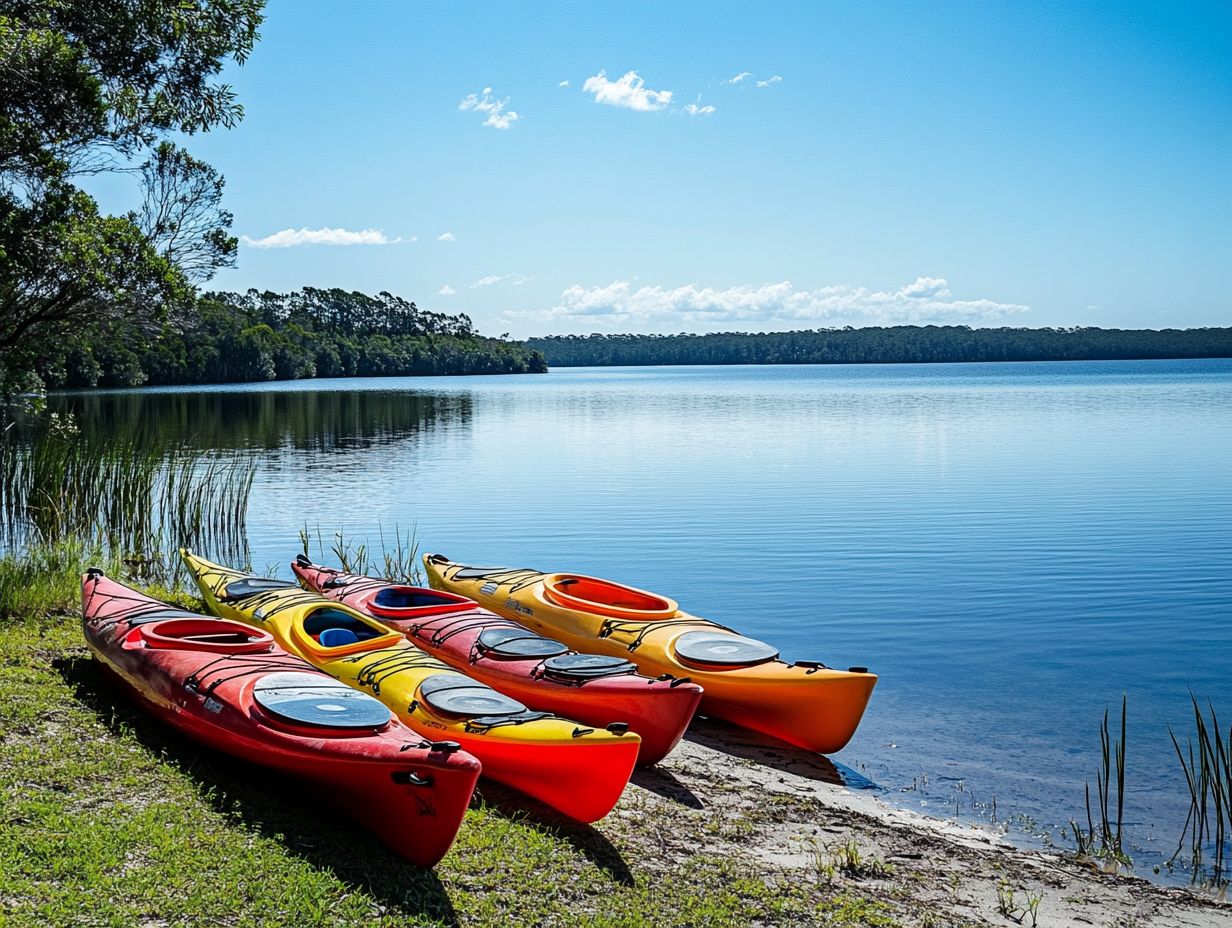
Setting a budget is essential when selecting a kayak! Prices can vary widely based on the brand, features, and materials used. This includes both inflatable kayaks, which can be filled with air, and hard-shell kayaks, made from solid materials.
Understanding these factors can lead to significant savings without compromising quality. Entry-level kayaks typically feature durable plastic and simple designs, making them perfect for casual users who prefer recreational options.
Higher-end models often use lightweight composite materials and come with advanced features like adjustable footrests and improved stability.
Brands like Pelican and Lifetime offer excellent budget-friendly choices, ensuring important aspects like comfort and safety are not sacrificed. Consider the type of kayaking you plan to do whether recreational, touring, fishing, or whitewater to clarify your decision while keeping your budget intact.
Frequently Asked Questions
What are the different types of kayaks available for different needs?
There are several types of kayaks, including recreational, touring, whitewater, inflatable, and sit-on-top. Each is designed for different purposes and water conditions.
What should I consider when choosing the right kayak for my needs?
When choosing a kayak, think about your skill level, intended use, water conditions, budget, and storage and transportation options.
What is the difference between a sit-in and sit-on-top kayak?
A sit-in kayak has a cockpit where the paddler sits inside the boat. In contrast, a sit-on-top kayak has an open-top design where the paddler sits on top, making it easier to get in and out.
Sit-in kayaks offer more protection from the elements, while sit-on-top kayaks are ideal for casual users.
Can I use a recreational kayak for whitewater kayaking?
No, recreational kayaks are not suitable for whitewater kayaking. They are better for calm waters like lakes and slow-moving rivers.
Inflatable kayaks or hard-shell kayaks may be more appropriate for adventurous outings.
What is the difference between a hard-shell and inflatable kayak?
A hard-shell kayak is made of solid materials like plastic or fiberglass, providing durability and better performance on the water.
Inflatable kayaks are made of durable, flexible materials and can be easily transported and stored when deflated, making them practical for those who value convenience!
Do I need any additional equipment when kayaking?
Yes, in addition to a kayak, you will need a paddle, a personal flotation device (PFD), proper clothing, and any necessary kayak safety equipment like a whistle and bilge pump. Having the right equipment is crucial for a safe and enjoyable kayaking experience.
Ready to find your perfect kayak? Start your adventure today!

